What Does the Sound of a Supercar Engine Really Mean?
Steve Arnott has perfect pitch. But not with musical notes; with engine notes. Think of Arnott as the Brian Eno of engines, the Quincy Jones of internal combustion. Typically, we hear about the latest in automotive design, of luxury carmakers updating their signature supercar silhouettes. But as the powertrain sound quality expert for Aston Martin, Arnott spends his days under the hood, fine-tuning the roar and rumble of a V12 to make sure it sounds – not looks – like an Aston Martin.
“You learn how to work with resonance in the pipes to make a certain note,” he explains. “Engines all produce the same frequencies, so it’s about emphasizing some over others, just as singers do. But for a car brand to have a distinctive engine sound is important. Most customers want what they feel to be an Aston Martin sound – put a Ferrari sound in an Aston Martin and it would just be wrong. And, although they wouldn’t admit it, it’s also because drivers like to be noticed in their car.”
Trying to describe the sound of an engine is difficult, but if anyone can do it, it’s Arnott. So, what exactly does an Aston Martin sound like? Arnott speaks on the “graveliness” of an Aston compared to the “low end rumbling” note of an American muscle car or the “high revving, screaming sound” of a Ferrari.
Ferrari is just as focused on its cars’ sonic qualities. “Each model is individually engineered to give it a recognizable sound, just like a musical instrument,” says Nicola Boari, Ferrari’s head of product marketing. “The sound is taken into consideration from the moment we start to engineer a new engine. Turbos, for example, literally act as a plug to engine sound”.

Some manufacturers have taken additional measures to ensure their vehicles sound right. BMW’s M5 uses the car’s stereo to play an amplified recording of its actual engine note, because the car’s cabin was too good at keeping noise out. Porsche, for example, has its ‘Sound Symposer’, a tube housing a diaphragm and a valve which opens to amplify the engine sound. Volkswagen has used what it calls a ‘Soundaktor’, a dedicated speaker located near the engine’s throttle body.
“Put a Ferrari sound in an Aston Martin and it would just be wrong.”
But, all this technology and engineering is threatened by new technology meant to quiet cars, to make them purr instead of roar. Also, all supercar manufacturers are inevitably turning their attention to electric vehicles, which only emit a faint hum. For most people, it won’t be a problem: for average commuters, a quiet car is a good car. But auto enthusiasts are wary. “We’re not too far down the road of developing an electric supercar, but clearly the sound is going to be an issue,” says Arnott.
Harley-Davidson, in contrast, has gone for a straight electronic replication of the muscular ‘hog’ sound for its LiveWire electric model. Mercedes-AMG has even enlisted rock band Linkin Park to help develop the right sound for its electric supercars.
As electric cars become the rule rather than the exception, supercar automakers are going to have to adjust. A study by the University of California, Riverside found that people had to physically be 74 percent closer to a hybrid car versus a gasoline one in order to hear it. The future could bring more fake sounds in the form of acoustic vehicle alerting system (AVAS), and an urban symphony of bleeps and chirps, car makers are already trying to work out how to make their sound right for their brand. But in the meantime, the sound of supercars are here to stay.










